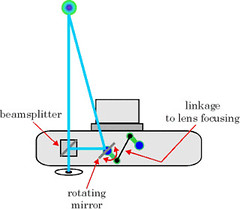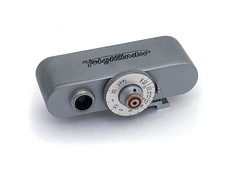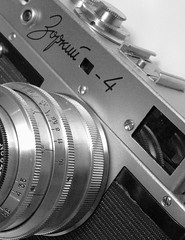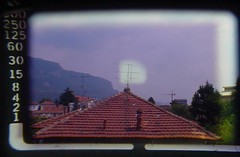Difference between revisions of "Rangefinder (device)"
m |
m (minor rewording) |
||
| Line 5: | Line 5: | ||
|image_text=diagram of how the system works | |image_text=diagram of how the system works | ||
}} | }} | ||
| − | A '''rangefinder''' is a focusing device. Cameras equipped with this device are called [[rangefinder camera]]s. There are two types of rangefinder: the '''coupled rangefinder''' has a linkage to the distance ring of the lens and lets you visually focus the camera on a subject, while the '''uncoupled rangefinders''' | + | A '''rangefinder''' is a focusing device. Cameras equipped with this device are called [[rangefinder camera]]s. There are two types of rangefinder: the '''coupled rangefinder''' has a linkage to the distance ring of the lens and lets you visually focus the camera on a subject, while the '''uncoupled rangefinders''' allows you to measure how far away you are from a subject on a distance knob whose setting you must then transfer to the camera's actual distance ring. |
| − | The diagram here shows how it works. The rangefinder is a ''coincident focusing device'', which displays two separate images. The main image is the entire frame of the viewfinder, while the secondary image is a small spot in the center of the frame. To focus on something, you aim the spot in the center at that something, which shows the two images. By turning the focus adjustment, you move the secondary image horizontally until it coincides with the main image. At this point, the | + | The diagram here shows how it works. The rangefinder is a ''coincident focusing device'', which displays two separate images. The main image is the entire frame of the viewfinder, while the secondary image is a small spot in the center of the frame. To focus on something, you aim the spot in the center at that something, which shows the two images. By turning the focus adjustment, you move the secondary image horizontally until it coincides with the main image. At this point, the rangefinder (and so the lens, if coupled) will be focused on the selected object. |
| − | The rangefinder works by splitting the image you see into two parts, using a ''beamsplitter''. This is a prism or a mirror which is "half-silvered", so that about half the light goes straight through it and the | + | The rangefinder works by splitting the image you see into two parts, using a ''beamsplitter''. This is a prism or a mirror which is "half-silvered", so that about half the light goes straight through it and the other half is reflected from it. The reflected path is aimed at another mirror which is on a rotating mount. This mount is coupled to the lens's focusing mechanism by a linkage, so that as you focus, the mirror rotates a very small amount. This causes the optical path to sweep left and right, which "moves" the secondary image. |
| − | Rangefinders are very accurate focusing devices, actually more accurate than through-the lens focusing screens on | + | Rangefinders are very accurate focusing devices, actually more accurate than through-the lens focusing screens on [[SLR]]s. Unfortunately, they suffer from [[parallax]] problems, where the framing of the scene through the viewfinder doesn't match that of the taking lens at close distances. |
{| | {| | ||
|- | |- | ||
| Line 26: | Line 26: | ||
|image= http://farm1.static.flickr.com/144/367782286_8c3522b022_m.jpg | |image= http://farm1.static.flickr.com/144/367782286_8c3522b022_m.jpg | ||
|image_align= left | |image_align= left | ||
| − | |image_text= | + | |image_text= front of a rangefinder camera with characteristic little extra viewfinder window |
}} | }} | ||
|| | || | ||
| Line 35: | Line 35: | ||
|image_align= right | |image_align= right | ||
|image_text= View through a viewfinder with superimposed | |image_text= View through a viewfinder with superimposed | ||
| − | + | rangefinder: The light image area in the middle | |
| − | + | shows the antenna doubled. That indicates that a | |
| − | + | distance selection change is needed to make a sharp image of that antenna. When the antenna would lie in the sharpness plane the rangefinder would show it just once. | |
| − | |||
| − | |||
}} | }} | ||
|} | |} | ||
Revision as of 03:01, 10 April 2008

|
| diagram of how the system works |
A rangefinder is a focusing device. Cameras equipped with this device are called rangefinder cameras. There are two types of rangefinder: the coupled rangefinder has a linkage to the distance ring of the lens and lets you visually focus the camera on a subject, while the uncoupled rangefinders allows you to measure how far away you are from a subject on a distance knob whose setting you must then transfer to the camera's actual distance ring.
The diagram here shows how it works. The rangefinder is a coincident focusing device, which displays two separate images. The main image is the entire frame of the viewfinder, while the secondary image is a small spot in the center of the frame. To focus on something, you aim the spot in the center at that something, which shows the two images. By turning the focus adjustment, you move the secondary image horizontally until it coincides with the main image. At this point, the rangefinder (and so the lens, if coupled) will be focused on the selected object.
The rangefinder works by splitting the image you see into two parts, using a beamsplitter. This is a prism or a mirror which is "half-silvered", so that about half the light goes straight through it and the other half is reflected from it. The reflected path is aimed at another mirror which is on a rotating mount. This mount is coupled to the lens's focusing mechanism by a linkage, so that as you focus, the mirror rotates a very small amount. This causes the optical path to sweep left and right, which "moves" the secondary image.
Rangefinders are very accurate focusing devices, actually more accurate than through-the lens focusing screens on SLRs. Unfortunately, they suffer from parallax problems, where the framing of the scene through the viewfinder doesn't match that of the taking lens at close distances.


